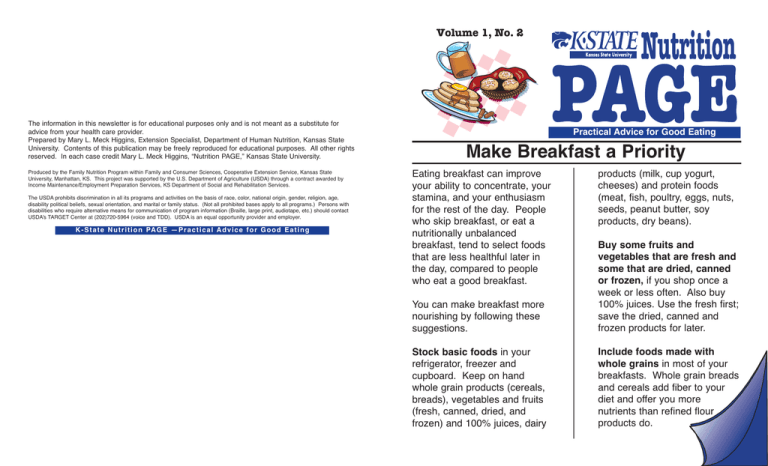
Volume 1, No. 2
The information in this newsletter is for educational purposes only and is not meant as a substitute for
advice from your health care provider.
Prepared by Mary L. Meck Higgins, Extension Specialist, Department of Human Nutrition, Kansas State
University. Contents of this publication may be freely reproduced for educational purposes. All other rights
reserved. In each case credit Mary L. Meck Higgins, “Nutrition PAGE,” Kansas State University.
Produced by the Family Nutrition Program within Family and Consumer Sciences, Cooperative Extension Service, Kansas State
University, Manhattan, KS. This project was supported by the U.S. Department of Agriculture (USDA) through a contract awarded by
Income Maintenance/Employment Preparation Services, KS Department of Social and Rehabilitation Services.
The USDA prohibits discrimination in all its programs and activities on the basis of race, color, national origin, gender, religion, age,
disability political beliefs, sexual orientation, and marital or family status. (Not all prohibited bases apply to all programs.) Persons with
disabilities who require alternative means for communication of program information (Braille, large print, audiotape, etc.) should contact
USDA’s TARGET Center at (202)720-5964 (voice and TDD). USDA is an equal opportunity provider and employer.
K - S t a t e N u t r i t i o n PA G E — P r a c t i c a l A d v i c e f o r G o o d E a t i n g
Practical Advice for Good Eating
Make Breakfast a Priority
Eating breakfast can improve
your ability to concentrate, your
stamina, and your enthusiasm
for the rest of the day. People
who skip breakfast, or eat a
nutritionally unbalanced
breakfast, tend to select foods
that are less healthful later in
the day, compared to people
who eat a good breakfast.
products (milk, cup yogurt,
cheeses) and protein foods
(meat, fish, poultry, eggs, nuts,
seeds, peanut butter, soy
products, dry beans).
You can make breakfast more
nourishing by following these
suggestions.
Buy some fruits and
vegetables that are fresh and
some that are dried, canned
or frozen, if you shop once a
week or less often. Also buy
100% juices. Use the fresh first;
save the dried, canned and
frozen products for later.
Stock basic foods in your
refrigerator, freezer and
cupboard. Keep on hand
whole grain products (cereals,
breads), vegetables and fruits
(fresh, canned, dried, and
frozen) and 100% juices, dairy
Include foods made with
whole grains in most of your
breakfasts. Whole grain breads
and cereals add fiber to your
diet and offer you more
nutrients than refined flour
products do.
Keep baked goods
in the freezer to keep their
taste fresh.
Choose three or more of the
five main food groups at each
breakfast. For example,
choose a whole grain cereal,
milk and fresh fruit, such as a
banana. Or select tomato juice,
100% whole-wheat toast, and a
scrambled egg. Or try a whole
grain waffle, cooked prunes,
and cup yogurt.
Vary your selections. Select
colorful fruits and vegetables
for good nutrition. Make
breakfast something you want
to wake up to!
Fast facts about breakfast
foods:
• Healthful, tasty breakfasts
don’t have to take much energy
to fix.
• A donut has five times more
fat than a bagel.
• Foods that aren’t "traditional"
for breakfast may be very
healthful choices.
• If you aren’t hungry soon after
you arise, drink your breakfast.
• A sausage & egg McMuffin
from McDonald’s has 27 grams
of fat, almost half of the recommended daily value for fat.
Healthful Breakfast Menu Ideas: Choose one item from three different
food groups, and then add more selections as desired.
Grain products—preferably
whole grains with fiber
• Bagels
• Pita pockets
• English muffins
• Whole grain breads
• Tortilla shells
• Hot cereal
• Rice
• Unsweetened ready to eat
cereals
• Baked muffins
• Waffles
• Pancakes
• Whole grain crackers
Vegetables group
• Low sodium vegetable
juice
• Low sodium tomato juice
• Cherry tomatoes, green
peppers, any vegetables
that you like
• Salsa
• Soup
Fruits group
• Fresh fruits, such as
grapes, bananas, berries,
grapefruit
• Frozen fruits, such as
pineapple, berries,
melons
• Juice-packed canned fruits
of all kinds
• 100% fruit juices in boxes,
cartons, cans or bottles
• Prunes, raisins, any dried
fruits that you like
Dairy foods group
• Cup yogurt (fruited or
plain)
• Cottage cheese
• Milk (plain or flavored)
• Hot chocolate
• Shredded or sliced cheese
• Breakfast drink mixes
• Cheese spreads
Protein foods group
• Peanut or soy butter
• Scrambled, boiled, fried or
poached egg
• Lean chicken, turkey, pork,
beef or fish
• Cooked dry beans with
seasonings
• Nuts
• Seeds
• Soy beverage
• Tofu
• Frozen prepared meal
• Leftovers from the day
before
Sweets and Fats group—use
sparingly
• Syrup
• Honey, jam or jelly
• Bacon
• Margarine, preferably
without hydrogenated
fats
• Cream cheese
Do yourself a favor—
Enjoy breakfast every day!


